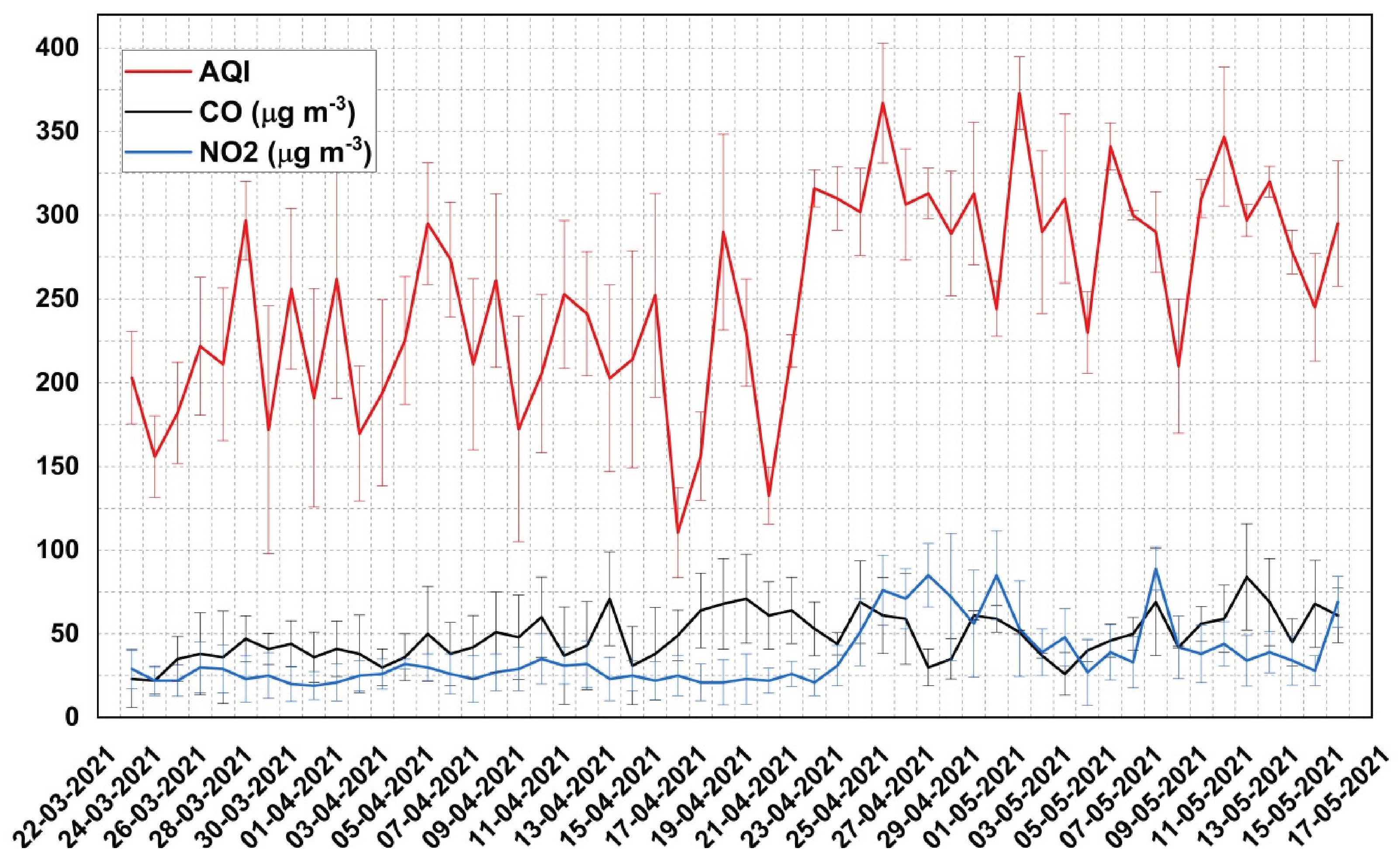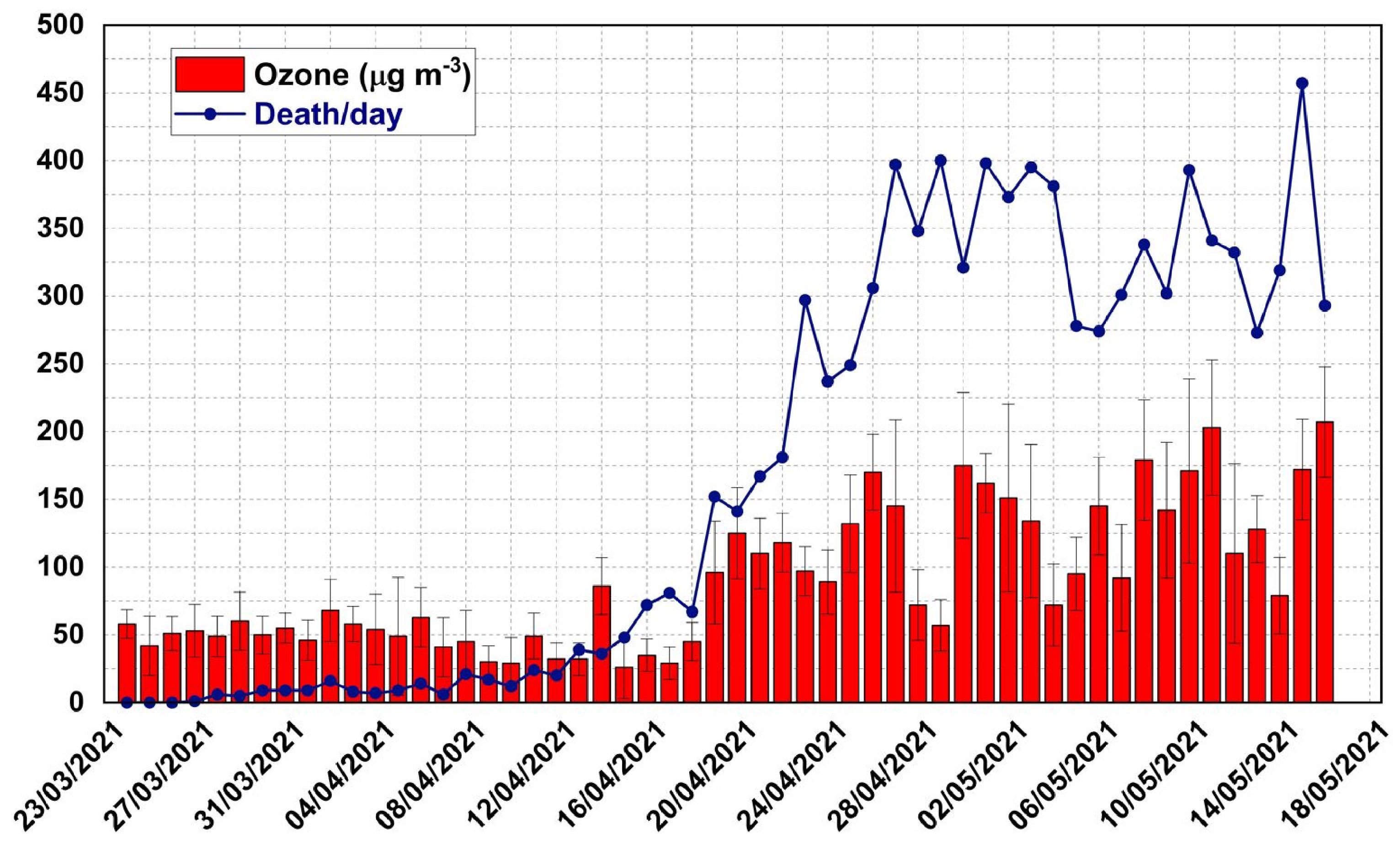Exacerbation of Fatality Rates Induced by Poor Air Quality Due to Open-Air Mass Funeral Pyre Cremation during the Second Wave of COVID-19
Abstract
:1. Introduction
2. Materials and Methods
2.1. Data and Geographical Features of Delhi
2.2. AirQ+: A Software Tool for Health Risk Assessment of Air Pollution
Short-Term Impact of Ozone
2.3. Chemistry of Surface Ozone
3. Results and Discussion
3.1. Role of Air Pollution in the Spread of COVID-19
3.2. Emission from Burning Funeral Pyres
3.3. Observed Pollution and Its Relation to COVID-19 Mortality
3.3.1. Assessing the Impact of Pyre Burning on Excess Mortality
4. Summary and Conclusions
Supplementary Materials
Author Contributions
Funding
Institutional Review Board Statement
Informed Consent Statement
Data Availability Statement
Acknowledgments
Conflicts of Interest
References
- Patel, K.; Campmier, M.J.; Bhandari, S.; Baig, N.; Gani, S.; Habib, G.; Apte, J.S.; Hildebrandt Ruiz, L. Persistence of Primary and Secondary Pollutants in Delhi: Concentrations and Composition from 2017 through the COVID Pandemic. Environ. Sci. Technol. Lett. 2021, 8, 492–497. [Google Scholar] [CrossRef]
- Antil, R.; Yadav, S.; Chaudhary, S. Assessment of impact of COVID-19 lockdown on air quality in national capital region of New Delhi, India. Holist. Approach Environ. 2022, 12, 70–78. [Google Scholar] [CrossRef]
- Hurley, F.; Miller, B.; Shafrir, A. Health Impact Assessment for the National Emissions Ceiling Directive (NECD)-Methodological Issues; European Environment Agency: Copenhagen, Denmark, 2011. [Google Scholar]
- Jayaraman, G.; Nidhi, P. Air pollution and associated respiratory morbidity in Delhi. Health Care Manag. Sci. 2008, 11, 132–138. [Google Scholar] [CrossRef] [PubMed]
- Jerrett, M.; Burnett, R.T.; Pope III, C.A.; Ito, K.; Thurston, G.; Krewski, D.; Shi, Y.; Calle, E.; Thun, M. Long-term ozone exposure and mortality. N. Engl. J. Med. 2009, 360, 1085–1095. [Google Scholar] [CrossRef] [PubMed] [Green Version]
- Finlayson-Pitts, B.; Pitts, J., Jr. Atmospheric chemistry of tropospheric ozone formation: Scientific and regulatory implications. Air Waste 1993, 43, 1091–1100. [Google Scholar] [CrossRef]
- Chen, Y.; Wild, O.; Ryan, E.; Sahu, S.K.; Lowe, D.; Archer-Nicholls, S.; Wang, Y.; McFiggans, G.; Ansari, T.; Singh, V.; et al. Mitigation of PM2.5 and ozone pollution in Delhi: A sensitivity study during the pre-monsoon period. Atmos. Chem. Phys. 2020, 20, 499–514. [Google Scholar] [CrossRef] [Green Version]
- Cruz, A.A. Global Surveillance, Prevention and Control of Chronic Respiratory Diseases: A Comprehensive Approach; World Health Organization: Geneva, Switzerland, 2007. [Google Scholar]
- Chakrabarty, R.K.; Pervez, S.; Chow, J.C.; Watson, J.G.; Dewangan, S.; Robles, J.; Tian, G. Funeral Pyres in South Asia: Brown Carbon Aerosol Emissions and Climate Impacts. Environ. Sci. Technol. Lett. 2014, 1, 44–48. [Google Scholar] [CrossRef]
- Nystrom, R.; Lindgren, R.; Avagyan, R.; Westerholm, R.; Lundstedt, S.; Boman, C. Influence of wood species and burning conditions on particle emission characteristics in a residential wood stove. Energy Fuels 2017, 31, 5514–5524. [Google Scholar] [CrossRef]
- Greenhalgh, T.; Jimenez, J.L.; Prather, K.A.; Tufekci, Z.; Fisman, D.; Schooley, R. Ten scientific reasons in support of airborne transmission of SARS-CoV-2. Lancet 2021, 397, 1603–1605. [Google Scholar] [CrossRef]
- Manoj, M.G.; Kumar, M.S.; Valsaraj, K.; Sivan, C.; Vijayan, S.K. Potential link between compromised air quality and transmission of the novel corona virus (SARS-CoV-2) in affected areas. Environ. Res. 2020, 190, 110001. [Google Scholar] [CrossRef] [PubMed]
- Baylon, P.; Jaffe, D.A.; Hall, S.R.; Ullmann, K.; Alvarado, M.J.; Lefer, B.L. Impact of Biomass Burning Plumes on Photolysis Rates and Ozone Formation at the Mount Bachelor Observatory. J. Geophys. Res. (Atmos.) 2018, 123, 2272–2284. [Google Scholar] [CrossRef]
- George, M.P.; J, K.B.; A, S.; S, M. Delhi smog 2012: Cause and concerns. J. Pollut. Eff. Control. 2013, 1, 10–4172. [Google Scholar]
- Rizwan, S.; Nongkynrih, B.; Gupta, S.K. Air pollution in Delhi: Its magnitude and effects on health. Indian J. Commun. Med. Off. Publ. Indian Assoc. Prev. Soc. Med. 2013, 38, 4. [Google Scholar]
- Sujith, B.; Sehgal, M. Characteristics of the ozone pollution and its health effects in India. Int. J. Med. Public Health 2017, 7, 56–60. [Google Scholar]
- Chossière, G.P.; Xu, H.; Dixit, Y.; Isaacs, S.; Eastham, S.D.; Allroggen, F.; Speth, R.L.; Barrett, S.R. Air pollution impacts of COVID-19–related containment measures. Sci. Adv. 2021, 7, eabe1178. [Google Scholar] [CrossRef] [PubMed]
- Mallik, C.; Gadhavi, H.; Lal, S.; Yadav, R.K.; Boopathy, R.; Das, T. Effect of Lockdown on Pollutant Levels in the Delhi Megacity: Role of Local Emission Sources and Chemical Lifetimes. Front. Environ. Sci. 2021, 9, 743894. [Google Scholar] [CrossRef]
- Resmi, C.T.; Nishanth, T.; Kumar, M.S.; Manoj, M.G.; Balachandramohan, M.; Valsaraj, K. Air quality improvement during triple-lockdown in the coastal city of Kannur, Kerala to combat Covid-19 transmission. PeerJ 2020, 8, e9642. [Google Scholar] [CrossRef] [PubMed]
- Son, J.; Jeong, S.; Park, H.; Park, C.E. The effect of particulate matter on solar photovoltaic power generation over the Republic of Korea. Environ. Res. Lett. 2020, 15, 084004. [Google Scholar] [CrossRef]




Publisher’s Note: MDPI stays neutral with regard to jurisdictional claims in published maps and institutional affiliations. |
© 2022 by the authors. Licensee MDPI, Basel, Switzerland. This article is an open access article distributed under the terms and conditions of the Creative Commons Attribution (CC BY) license (https://creativecommons.org/licenses/by/4.0/).
Share and Cite
Manoj, M.G.; Satheesh Kumar, M.K.; Valsaraj, K.T.; Vijayan, S.K.; Nishanth, T. Exacerbation of Fatality Rates Induced by Poor Air Quality Due to Open-Air Mass Funeral Pyre Cremation during the Second Wave of COVID-19. Toxics 2022, 10, 306. https://doi.org/10.3390/toxics10060306
Manoj MG, Satheesh Kumar MK, Valsaraj KT, Vijayan SK, Nishanth T. Exacerbation of Fatality Rates Induced by Poor Air Quality Due to Open-Air Mass Funeral Pyre Cremation during the Second Wave of COVID-19. Toxics. 2022; 10(6):306. https://doi.org/10.3390/toxics10060306
Chicago/Turabian StyleManoj, M. G., M. K. Satheesh Kumar, K. T. Valsaraj, Soumya K. Vijayan, and T. Nishanth. 2022. "Exacerbation of Fatality Rates Induced by Poor Air Quality Due to Open-Air Mass Funeral Pyre Cremation during the Second Wave of COVID-19" Toxics 10, no. 6: 306. https://doi.org/10.3390/toxics10060306
APA StyleManoj, M. G., Satheesh Kumar, M. K., Valsaraj, K. T., Vijayan, S. K., & Nishanth, T. (2022). Exacerbation of Fatality Rates Induced by Poor Air Quality Due to Open-Air Mass Funeral Pyre Cremation during the Second Wave of COVID-19. Toxics, 10(6), 306. https://doi.org/10.3390/toxics10060306







